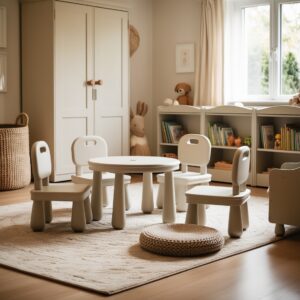New environments can be yet another exciting component of growth and development for a toddler. But more importantly, as parents, it is our concern to let them be safe in their exploration. This article gives some imperative views on essential toddler safety tips, related to new and unfamiliar environments, which will help in the protection of their little ones anywhere they go.
1. Planning for New Environments: Things to Consider
Before taking your toddler to a new environment-be it a relative’s house, playground, or other public places, survey the environment for any element of danger. This preliminary step will allow you to devise some strategies to minimize risks, hence allowing for a smooth sailing of events.

2. Essentials to Carry Along to Ensure Safety for Toddlers
Packing just the right thing can make all the difference in maintaining toddlers’ safety in new environments. A selection of some of them are shown below:
- First-aid kit: band-aids, antiseptic wipes, and allergy medications;
- portable child-proofing items: outlet covers and corner protectors for indoor locations;
- child locator or GPS bracelet: very helpful during visits to crowded places such as zoos, museums, shopping malls, etc.
3. Safety Tips for Visiting Other Homes
Keep in mind that other people’s homes aren’t childproof when you’re visiting friends or family. Here are some helpful tips:
- Furniture stability check: ensure that bookshelves or heavy furniture cannot tip over.
- Supervise around stairs: most homes may be without gates; keep in mind that you or another adult will always be in supervision.
- Remove accessible hazards: small items like buttons or coins, which usually lie on tables or shelves, are choking hazards.

4. Public Spaces and Outdoor Safety Tips
Places like parks, playgrounds, and even sidewalks all pose unique toddler-safety challenges. The following advice will help you keep your youngster safe:
- Stay within arm’s reach: This is absolutely important whenever near any body of water or uneven surfaces.
- Smear sunscreen and protective clothing: Protect their skin from sun exposure.
- Teach boundaries: Let them know to stay within a certain area or near a certain landmark.

5. Toddler Safety in Crowded Places
Crowded places are large areas that may be enclosed, such as malls, or open, such as festivals. They can be overwhelming for toddlers and can even become dangerous. To avoid these types of dangers, take note of the following:
- Use Child Harnesses or Wristbands: Child harnesses or wristbands can help prevent them from running away from your line of vision.
- Teach Them to Stay Close to You: Establish a rule for them to stay close and practice it consistently.
- Identify Safe Helpers: Teach them to approach uniformed personnel such as staff or security guards in case they feel lost.
6. Safety During Outdoor Adventure and Travel
Safety always comes first whenever taking the toddlers on outdoor hikes or for new travel destinations. Following are a few helping tips:
- Dress them in bright colors: It pays when you need to spot them quickly if they wander.
- Teach basic directions: Even young children can learn key phrases like “Stay here” or “Hold my hand.”
- Emergency whistle: Attach a small whistle to their clothing to sound if they become separated from you.
7. Home Toddler Safety When Adding New Furniture or Decor
Sometimes, the “new environment” can be at home when moving into a new house or simply redecorating. Here are a few toddler safety tips for adapting to these changes:
- Secure new furniture: Ensure new shelves, dressers, and TVs are fastened to the wall.
- Update childproofing items: Check to see if baby gates, cabinet locks, and outlet covers are installed.
- Prepare a child-friendly play area: The area should be a safe zone, equipped with various toys and activities that will keep them busy yet within sight.

8. Additional General Tips to Safeguard Toddlers in Any Environment
Whether indoors or outdoors, these will further strengthen toddler safety in whatever environment:
- Practice “stop” and “no”: Terms like “stop” or “no” can be practiced to make the toddler recognize impending danger.
- Simplify safety: For example, “Hot, don’t touch” for heaters or stoves.
- Practice routines: Before exposing your child to a different environment, practice listening games in your home to establish attentive behavior.
By preparing your child for the different environments they may experience, packing the right materials, and teaching your toddler some simple safety skills, you are ready to enjoy this journey together with peace of mind. With these safety tips for toddlers, each experience will be fun and safe for your child.



